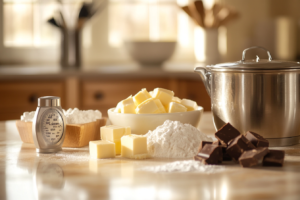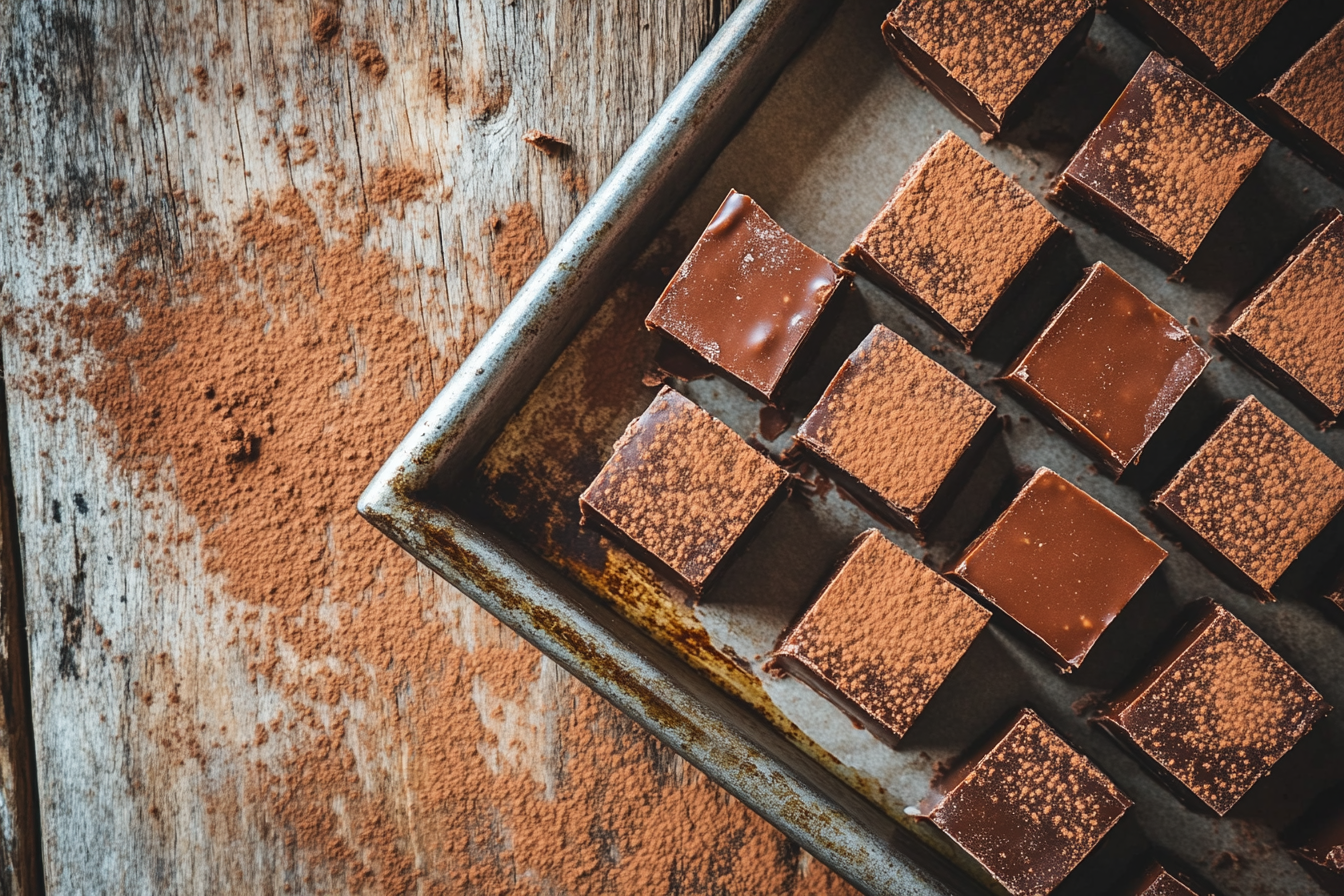Creating truly delicious fudge can feel like a science and an art all in one. Many fudge lovers know how challenging it can be to get that perfect, smooth texture without it turning grainy or overly hard. In this article, we’ll dive into what is the secret to good fudge, exploring tips, ingredients, techniques, and even troubleshooting for common mistakes. Whether you’re a beginner or a seasoned fudge-maker, this guide will help you achieve the rich, creamy results everyone craves. Let’s start by looking at the key ingredients that make all the difference.
Key Ingredients for Good Fudge – The Foundation of Flavor and Texture

What is the Secret to Good Fudge? Understanding the Ingredients
When it comes to making the perfect fudge, each ingredient plays a role in creating that ideal balance of smoothness, richness, and flavor. Let’s explore these essential components that unlock the secret to good fudge.
The Role of Sugar in Perfect Fudge
The type of sugar in your fudge mixture can make or break the result. Granulated sugar is typically recommended for most fudge recipes due to its ability to dissolve evenly, forming the ideal crystallization. Crystallization is essential for good fudge texture, as it ensures that smooth, creamy consistency everyone loves. Opt for high-quality sugar to avoid any grainy or uneven textures that can compromise the fudge.
Why Fat Content Matters – Butter and Cream for Good Fudge
To achieve the richness associated with perfect fudge, the fat content from ingredients like butter and cream is crucial. Butter adds a luxurious, velvety texture, while cream contributes to the body and smooth mouthfeel. For best results, choose unsalted butter and heavy cream, which give you more control over flavor. Some fudge recipes may substitute evaporated milk, which also adds richness without adding too much water content.
Choosing the Right Chocolate for the Best Fudge Results
If you’re crafting chocolate fudge, the quality and type of chocolate you use will affect both flavor and texture. Opt for high-quality semi-sweet or bittersweet chocolate, which melts smoothly and delivers a deep, rich taste. Avoid overly sweet or low-quality chocolate, as it may lead to a fudge that lacks depth and turns out too sweet.
Adding Flavors and Texture Enhancers
Enhancing the basic fudge recipe with optional add-ins can elevate the final result. Vanilla extract, for instance, rounds out the sweetness, while a touch of salt can bring balance. Nuts like walnuts or pecans add a pleasant crunch and depth, transforming the fudge into a delightful multi-textured treat.
The Science Behind Perfect Fudge Texture
Why Texture Matters in Good Fudge
Achieving the right texture is a crucial part of discovering what is the secret to good fudge. Texture defines whether your fudge will be smooth and creamy or hard and grainy. Understanding the science behind each step can make the difference between just okay fudge and truly exceptional fudge.
The Role of Temperature in Perfect Fudge Texture
One of the most critical elements in making good fudge is reaching the correct temperature. Temperature directly affects how sugar crystals form, which in turn influences the texture. Fudge should ideally reach a temperature of about 234°F to 240°F (the “soft-ball stage”) on a candy thermometer. At this stage, the sugar is dissolved, allowing the mixture to set with a creamy texture rather than a gritty one.
The Importance of Stirring in Making Good Fudge
Stirring is another step that impacts fudge texture significantly. The timing and method of stirring influence crystallization; stirring too early can create unwanted large sugar crystals, leading to a grainy texture. Once your fudge reaches the right temperature and has cooled slightly, stir it steadily until it begins to thicken and lose its shine. This process gives fudge its smooth, melt-in-the-mouth consistency.
Crystallization and Achieving Smooth Fudge
To make smooth fudge, managing crystallization is essential. By controlling temperature and stirring at the right times, you encourage small sugar crystals to form, resulting in the creamy texture fudge is famous for. If crystallization happens too early or unevenly, you’ll end up with fudge that feels sandy or coarse. So, always keep an eye on the temperature and allow some cooling before stirring.
Tools and Equipment for Making Good Fudge
Using a Candy Thermometer for Precision
A candy thermometer is indispensable for making fudge. It helps you monitor the exact temperature, taking the guesswork out of reaching that critical “soft-ball stage.” Aim for around 234°F and avoid any deviations to keep the fudge texture spot on.
Why a Heavy-Bottomed Saucepan Matters
Using a heavy-bottomed saucepan is another secret to good fudge. This type of pan distributes heat more evenly, preventing hot spots that could burn the mixture. A burnt fudge mixture is challenging to salvage, so investing in a quality pan can be worth it for consistently delicious results.
By understanding these factors—temperature, stirring, and equipment—you’ll be well on your way to mastering the art of making perfectly smooth, creamy fudge every time.
Step-by-Step Guide to Making Perfect Fudge
Preparing Ingredients and Equipment for Good Fudge
Before starting, having everything set up correctly will make your fudge-making process smoother and more enjoyable. Proper preparation ensures that you’re not scrambling mid-recipe, which can lead to mistakes.
Measuring Ingredients Accurately for Consistent Fudge Texture
Precision in measuring is key to achieving consistent results with good fudge. Use measuring cups and spoons specifically for dry and liquid ingredients to ensure accuracy. Even small variations in ingredient ratios can affect the final texture and taste, so measure carefully.
Setting Up Your Workspace
Organizing your workspace with all the ingredients, tools, and equipment at hand can make the process far less stressful. Have your candy thermometer, heavy-bottomed saucepan, and prepared pan (lined with parchment or lightly buttered) ready to go before you start cooking.
Cooking the Fudge Mixture for Optimal Fudge Consistency
This stage is where most of the magic happens, and careful attention is crucial. Let’s dive into the essential steps for cooking the fudge mixture to perfection.
Heating and Melting Ingredients
To begin, combine your sugar, butter, and cream (or milk) in the saucepan over medium heat. Stir gently as these ingredients melt together, ensuring they don’t burn or stick. Avoid stirring too vigorously, as it can cause premature crystallization.
Reaching the Ideal Temperature – The Soft-Ball Stage

As you cook the mixture, it’s essential to keep an eye on the temperature. Using your candy thermometer, aim to reach the “soft-ball stage” at around 234°F to 240°F. This temperature ensures the sugar has dissolved adequately, allowing the fudge to set properly. Be patient—hasty temperature changes can cause the fudge to turn grainy.
Cooling and Stirring – Crucial Steps for Smooth, Creamy Fudge
After reaching the desired temperature, remove the pan from heat and let the fudge cool slightly. This cooling phase is essential to prevent crystallization issues and achieve a smoother texture.
Allowing Fudge to Cool Before Stirring
Cooling gives the fudge mixture time to settle and can make the stirring process more effective. A short wait of 5-10 minutes lets the temperature drop, which helps prevent the formation of large sugar crystals that would make the fudge grainy.
Stirring for the Right Consistency
Once cooled slightly, begin stirring the fudge with a wooden spoon or spatula. Stir until it thickens and loses its shine, which indicates it’s close to setting. The stirring motion encourages the formation of small sugar crystals, essential for a smooth texture. However, avoid over-stirring, which can lead to a crumbly finish.
Pouring and Setting the Fudge for Perfect Results
Once your fudge reaches the right consistency, it’s time to pour it into a prepared pan for setting.
Preparing the Pan for Easy Removal and Clean Cuts
Line a square pan with parchment paper or lightly butter it to prevent sticking. This step makes removing the fudge easier and ensures clean cuts when serving.
Allowing Time for Fudge to Set
After pouring the fudge into the pan, let it sit at room temperature until it fully sets. This can take several hours, so patience is key! Avoid placing it in the refrigerator, as this can disrupt the texture and make the fudge dry or brittle.
By following these steps, you’ll be able to make perfect fudge with a rich, creamy consistency that everyone will love. With practice, these techniques will become second nature, helping you create consistently delicious fudge every time.



2 thoughts on “What is the Secret to Good Fudge?”